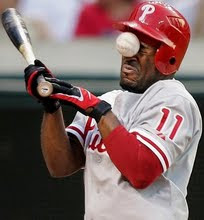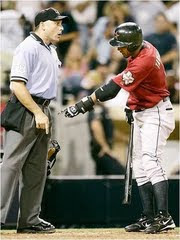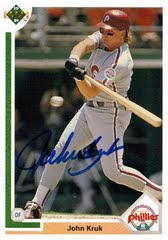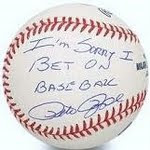A quintessential component of
The Quintessential Sabermetrics Argument: Batting Average was that a lot of batted ball data tends to normalize because hitters do not have as much control over balls in play (BIP) as commonly believed. True, players who consistently make
certain kinds of contact more often can
maintain higher BABIPS, as can
speedsters, but once the ball is in play, whether or not that balls is a "hit" is highly dependent on the positioning and ability of the defense.
From here, we turn from batters to pitchers. A pitcher controls a few things about the outcome of an at bat, each to a variable degree:
A pitcher is in almost absolute control over the general location of his pitch. There are some marginal variants such as temperature, wind speed and wind direction in effect, but a pitcher who does not hit his spots can generally only blame himself. He either gripped the ball incorrectly, released it too late, "has the jitters," just can't pitch, etc. The location of his pitch is something in his control.A pitcher also almost completely (though less completely than location) controls intentional walks. The Jeff Francouer and Miguel Cabreras of the world aside, if a pitcher wants to intentionally walk a batter, it will happen.Compared to intentional walks, a pitcher exercises less control, but still a large degree of control, over unintentional walks. Unintentional walks integrate the batter more into the outcome equation and the result is less guaranteed (largely because players like Bengie Molina and umpires like Tim McClellan do not understand the concept of a strike zone). Generally speaking, however, a pitcher controls the general location of his pitches and batters will more often than not lay off pitches outside of the zone.A pitcher exercises much less control over strikeouts than he does walks, but he still exercises a large degree of control over them. This decline in control over the outcome occurs because the batter is more integrated into the strikeout process. Whereas with walks a player takes a passive role, the hitter is now taking active participation against the pitch; he can lay off or swing and the result will either be contact or no contact. A pitcher with deceptive release points, sharp break and a large velocity disparity between pitches will tend to "fool" batters more often, whereas hitters can more easily square up straight pitches with no movement. Although the pitcher controls the type of his pitch, the degree of deception, the movement, etc., he does not control whether or not the hitter will be able to guess where the ball's true location will be. What the pitcher controls, therefore, is the ability to influence batter's probability of contact; we just simplify this statement in the form of "strikeouts."
As we move from no contact to contact, the degree of control a pitcher exercises over the outcome of an at bat declines further. A pitcher does not control the actual outcome (type of contact) of the at bat (this is because there is no magic "groundball-only-and-always" pitch), but he does exert influence over the tendency of type of contact to result from the at bat. A pitcher who throws pitches with sharper break is more likely to have a hitter get "on top of the ball" and chop it into the ground. A pitcher does not, however, control the strength of the resulting contact. I would say that pitchers with more deceptive "stuff" are more likely to induce weaker contact than the average pitcher, but once the ball is out of their hands, the question of contact becomes something only the hitter can answer. The ball en route, the hitter must guess where and how to swing. Assuming he does not strikeout, if he guesses poorly, the result with be weak contact -- an infield flyball or weak grounder. If he guesses correctly, the resulting contact will be stronger and harder hit. Because the pitcher controls the tendency of the ball to be in the ground or in the air, but he does not control how hard it will be hit on the ground or in the air or how far, then it makes sense that a pitcher does not control home runs; only the tendency thereof. Pitchers face so many batters that we can generally assume that the average hitter they will face will have "league average" power. The guy with the league average power hits just over a home run per every 10 flyballs he hits. We call this HR/FB rate (I prefer HR/non-GB rates as a whole, as line drives also turn into home runs sometimes, but HR/FB rate is sufficient for our purposes). The league, as a whole, averages a HR/FB rate in the 11% range, though most pitchers have HR/FB% which normalize to the 9-12% range (depending on where they play). Pitchers, over a large enough sample size, regress into this range because they do not control how hard batters will hit their non-groundball-resultant offerings. Since 2002, 73 pitchers have cumulatively thrown 1000+ innings. Of them, only Jason Schmidt (7.5%), CC Sabathia (8.4%), Cliff Lee (8.5%), Barry Zito (8.6%), Mark Redman (8.8%), Jarrod Washburn (8.8%), Roger Clemens (8.9%), Pedro Martinez (8.9%), Odalis Perez (12.3%), Nate Robertson (12.7%), Derek Lowe (12.7%), Brandon Webb (13.2%), and Brett Myers (15.5%) -- at total of 13 pitchers (five of whom just barely made the cut) -- did not fall into the 9%-12% HR/FB ratio range. Of them, Lee, Sabathia, Zito, and Washburn pitched at exteme home run suppressing parks for most of the sample size, while Webb and Myers pitched at extreme home run exaggerating parks. You might also notice Derek Lowe and Brandon Webb's presence here, despite being the league's two most extreme groundball-oriented pitchers; this only further drives home the point.Does a pitcher control pop ups? A pitcher certainly controls flyball tendencies, but it is uncertain if "inducing pop ups" is a skill possessed by pitchers. Certainly 2002-2006 Barry Zito would have you believe so. I have no seen any conclusive scientific evidence either way, but I can affirmatively state that pitchers who induce more infield flyballs tend to have lower BABIPs.What about hits? A pitcher exerts almost no control over non-home run hits. As mentioned above, once the ball is out of the pitcher's hand, it is out of his control (at least from the perspective of pitching ability). Once the ball is put in play, it is the fielders who determine whether or not a ball is going to be a hit. The pitcher may control the direction of the ball, like he does the type of contact, but it is the hitter's guess of the pitch (often which is random in and of itself) which determines if it is a ball down the line, right to the third basemen, hit to the gap, etc.Left On Base Percentage (LOB%) is another element that pitchers exercise very little control over. Although better pitchers tend to have higher LOB%, LOB% nonetheless regress to some mean, whether it be that of the league average or player's career average. The reason why is very closely related to the "pitcher does not control hits" argument. Because the pitcher does not control if a specific at bat where contact is made results in a hit, a pitcher does not control when contact is made. This means that they do not control BABIP by leverage (a term used to describe how important or impactful upon the probability of outcome a specific situation in a game is). Sure, a pitcher is more likely going for the strikeout or for a groundball when there are runners on base and the game on the line, but the BABIP results and contact% generally remain stagnant over large enough sample size comparisons of situations with variable leverage indexes. This goes towards that whole "there is no such thing as clutch" argument. From all of the aforementioned reasons, it is important to look beyond ERA and WHIP in evaluating a pitcher's true ability beyond the success he does or does not experience in a single season. ERA measures single-season results with all the non-neutral luck variables factored in. Using ERA to identify a pitcher's talent is like trying to identify a pieces of strawberry in a finely blended all-berry smoothie (food metaphor). We need to look beyond what a pitcher does not control and into what a pitcher does control. This is where FIP or Fielding Independent Pitching statistics (which you may know it as DIPS, or Defense Independent Pitching Statistics) comes in handy. The statistical analysis grunt work has already been done (thanks to Tom Tango) and the coefficient of determination is pretty high (approximately five times that of ERA).
FIP is a better measure of future success than ERA. FIP essentially takes the three elements a pitcher exerts the most control over (K's, BB's and HR's) and weights them in regard to their historical impact on ERA and then adds to them a league-specific factor to round out the resulting number to an equivalent ERA number. The formula for calculating FIP is 3.2+((13*HR)+(3*(BB+HBP-IBB))-(2*K))/IP. ERA tends to regress towards FIP over time. It likely will not match it (too many variables at play), but you can determine whether a player is likely to improve or regress in the future based on FIP-ERA differentials (FIP-based trading and team management is a cornerstone of fantasy baseball success).
But wait, DME, you say, didn't you just say, and I quote, "a pitcher does not control home runs; only the tendency thereof?" You are correct and this brings me to the advanced form of FIP I prefer to utilize called expected FIP or xFIP ("x" is a general term you see in front of statistics to represent some predicative value). xFIP is similar to FIP in how it incorporates the historical weight of K's, BB's and HR's on ERA, but whereas FIP uses a pitcher's in-season home run totals to calculate a pitcher's in-season FIP, xFIP uses a metrics we might call xHR, where xHR is a specific function of the league average HR/FB rate. xFIP measure's a player's future ERA under the theory of HR/FB rate regression.
There is another FIP-like metric out there called
tRA, which utilizes a pitcher's total batted ball profile to evaluate his luck-neutral results from a single season and predict a player's future ERA. tRA is not exactly scaled to reflect ERA, so it can be a bit confusing. I personally do not use tRA because I do not believe a pitcher controls "line drives" (
at least not as classified and encapsulated in box score data).
From all this explanation and ramble, we derive the following maxims. A pitcher who walks less batters, strikes out more batters and keeps the ball on the ground is likely to succeed. A pitcher who induces more contact and pitches for the
2007 White Sox is not.







0 comments:
Post a Comment